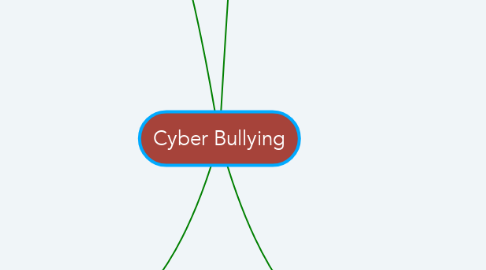
1. Videos
1.1. Cyber Bullying Virus
1.1.1. Makes cyber bullying look a disease we can fight
1.1.2. It shows how hurtful it really can be on someone
1.1.3. Highlight's the major long term impact of bullying
1.1.4. Also shows ways to help a friend who is being affected
1.1.5. A very powerful message is told
1.2. Protect Yourself Rules - Cyber Bullying
1.2.1. Gives people basic rules to help protect yourself
1.2.2. Block, report and tell an adult are helpful to help stop bullies
1.2.3. "Think before you post"
1.2.4. Stand up for yourself
1.2.5. You never know what someone is going through
2. Statistics
2.1. 1 in 5 young Australian people reported being socially excluded, threatened or abused online
2.2. 53% of young Australians have experienced cyberbullying
2.3. 84% of Students who were bullied online were also bullied in person
2.4. 72% of schools reported managing at least one incident of online bullying
2.5. 87% of young people have witnessed cyber bullying of some kind
2.6. 88% of bullies are known to the target
2.7. 65% of targets ignore the bullying, 35% fight back
2.8. 47% of young people seek support from a parent, 33% see a friend and 24% talk to a teacher
2.9. 85% of peers are bystanders and play important role in the bullying process
2.10. Online bullying appears to be related to age (or access to technology), with secondary students more likely to engage in bullying online than primary school students
3. Ideas
3.1. Can be really hurtful
3.2. Hard to escape
3.3. Luke is strong
3.4. Keyboard Warriors
3.5. It can affect anyone
3.6. Mentally draining
3.7. Words hold a lot power
3.8. Online bullying
3.9. it isn't okay
3.10. Can destroy families
4. Websites
4.1. Cyberbullying (for Teens) - Nemours KidsHealth
4.1.1. Police can get involved and serious legal trouble
4.1.2. Can have long term affects like depression and anxiety
4.1.3. Tell someone, walk away, resist urge to respond, save evidence, report and block the bully
4.1.4. Online bullying can be easier to commit
4.2. https://kidshelpline.com.au/teens/issues/cyberbullying
4.2.1. bullying is ongoing actions that are intended to harm someone else physically or mentally
4.2.2. Heaps of reason why people bullying some are:
4.2.2.1. Jealousy
4.2.2.2. Inner angry
4.2.2.3. Want others to like them
4.2.2.4. Need to have power over someone
4.2.3. Some of the effects on the person are:
4.2.3.1. Trouble sleeping
4.2.3.2. Lose appetite
4.2.3.3. thoughts about hurting yourself
4.2.3.4. feel alone, sad or confused
4.2.4. Support is always available
4.2.4.1. Talk to someone you trust
4.3. Cyberbullying
4.3.1. Many different ways it can be done:
4.3.1.1. mean/hurtful texts
4.3.1.2. nasty messages through social media
4.3.1.3. sending photos/videos to embarrass you
4.3.1.4. excluding you from group chats
4.3.1.5. setting up fake profiles acting like you
4.3.2. It is very hard to deal with because
4.3.2.1. heaps of people can be invloved
4.3.2.2. the content can spread quickly
4.3.2.3. very hard to escape as we use technology everyday
4.3.2.4. Hard to remove as it is online and can saved everywhere
4.3.2.5. Often done behind a fake account
4.3.3. The effects on the victim
4.3.3.1. hopeless
4.3.3.2. stressed out
4.3.3.3. rejected by frineds
4.3.3.4. unsafe at school
4.3.3.5. blame themselves
4.4. New data finds more than half of Aussie kids experience cyberbullying
4.4.1. 6 steps for parents
4.4.1.1. listen calmly to the full story
4.4.1.2. Reassure the young person its not their fault
4.4.1.3. Ask young person what they want to do
4.4.1.4. talk about helpful strategies to guide young person
4.4.1.5. contact the school
4.4.1.6. Check in regularly
4.5. https://www.esafety.gov.au/key-issues/cyberbullying
4.5.1. Signs to watch for:
4.5.1.1. upset after being on phone
4.5.1.2. changes in personality
4.5.1.3. unexpected changes in friendship groups
4.5.1.4. decline in their school work
4.5.1.5. becoming more secretive with social media
4.5.2. Be an upstander not a bystander
4.5.2.1. DM your friend to check if they are okay
4.5.2.2. stand up to the bully if you feel safe and confident
4.5.2.3. get extra help from a counselling or support service
4.5.2.4. help your friend report people/person
4.5.3. Someone spreading rumours online
4.5.3.1. don't retaliate
4.5.3.2. offer a new perspective
4.5.3.3. message the person being targeted
4.5.3.4. report the post
4.5.3.5. get outside help

